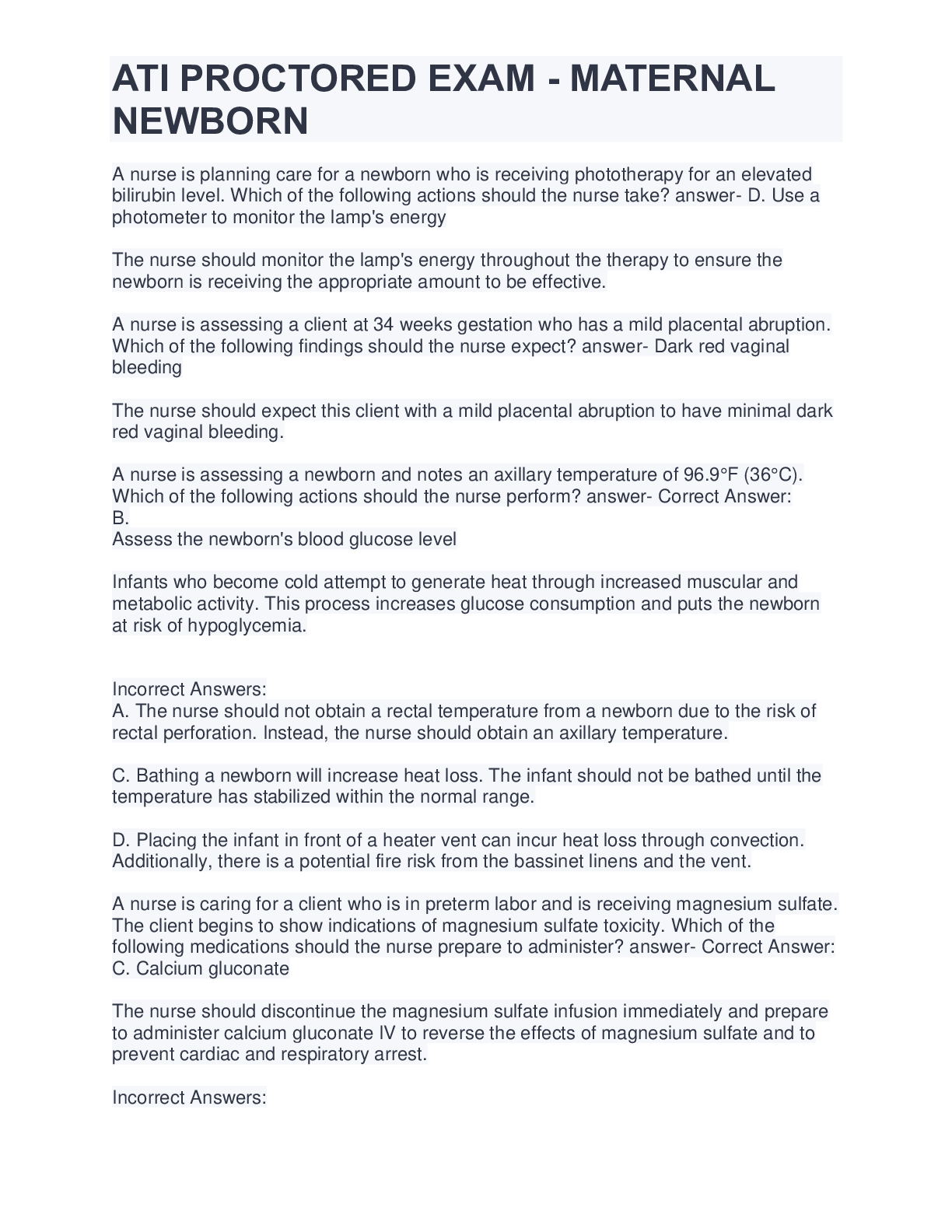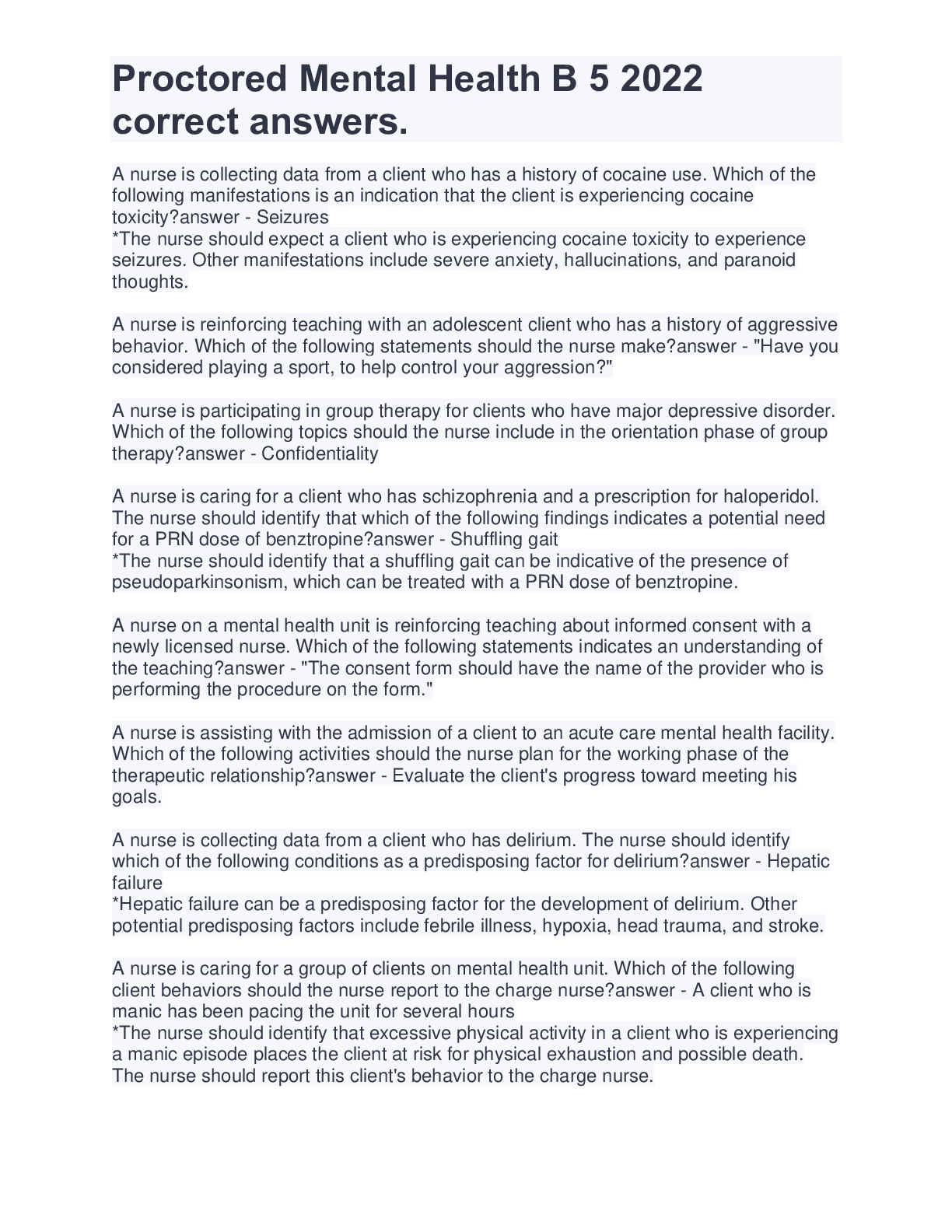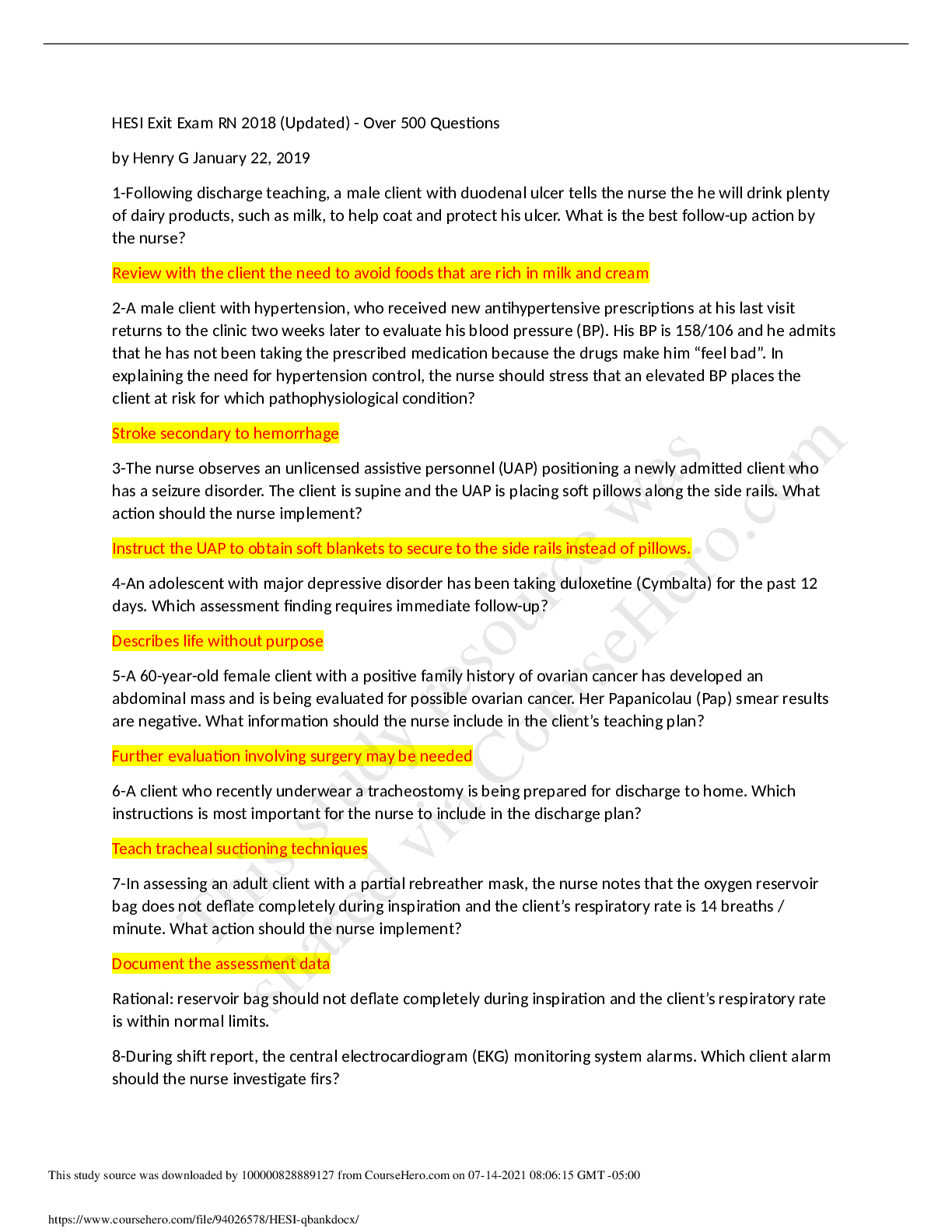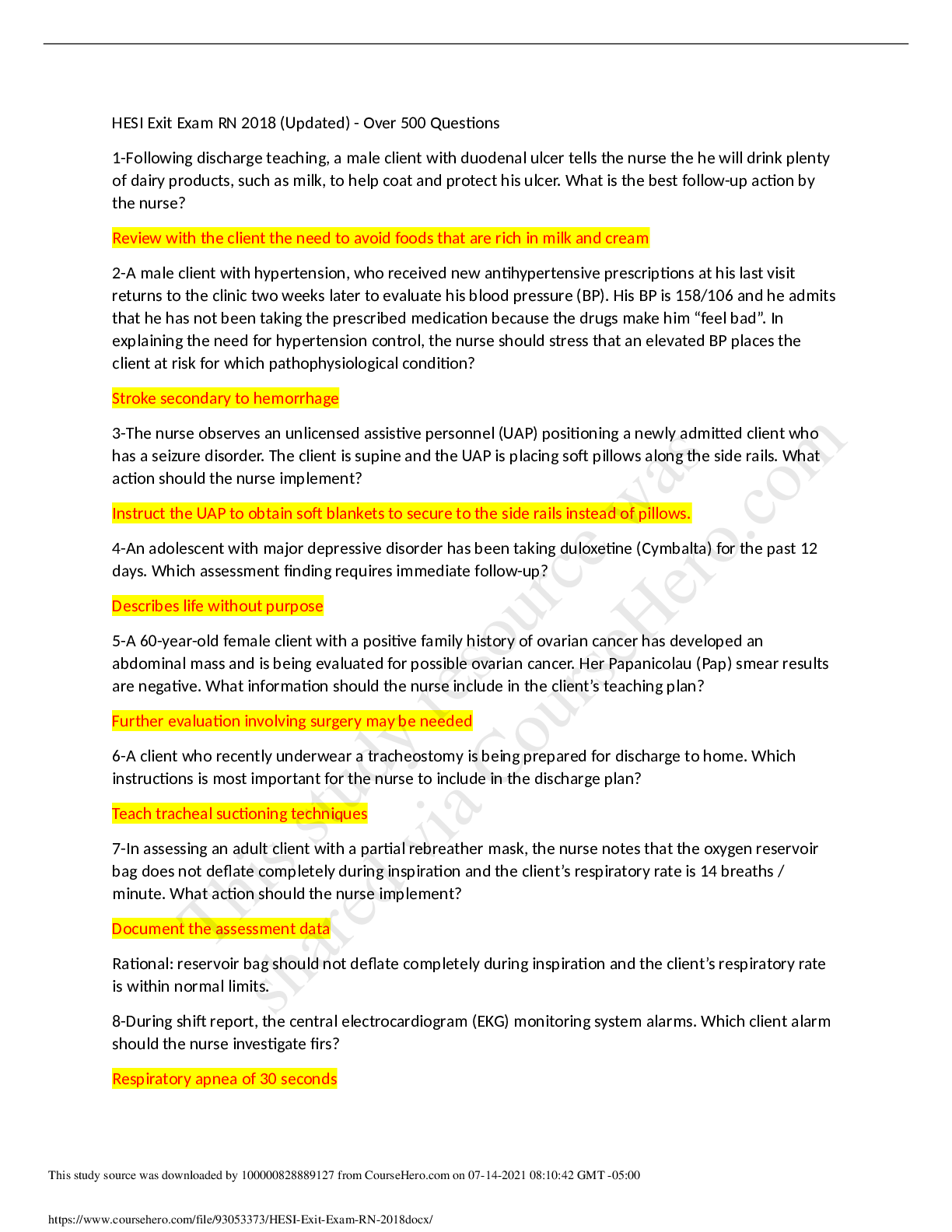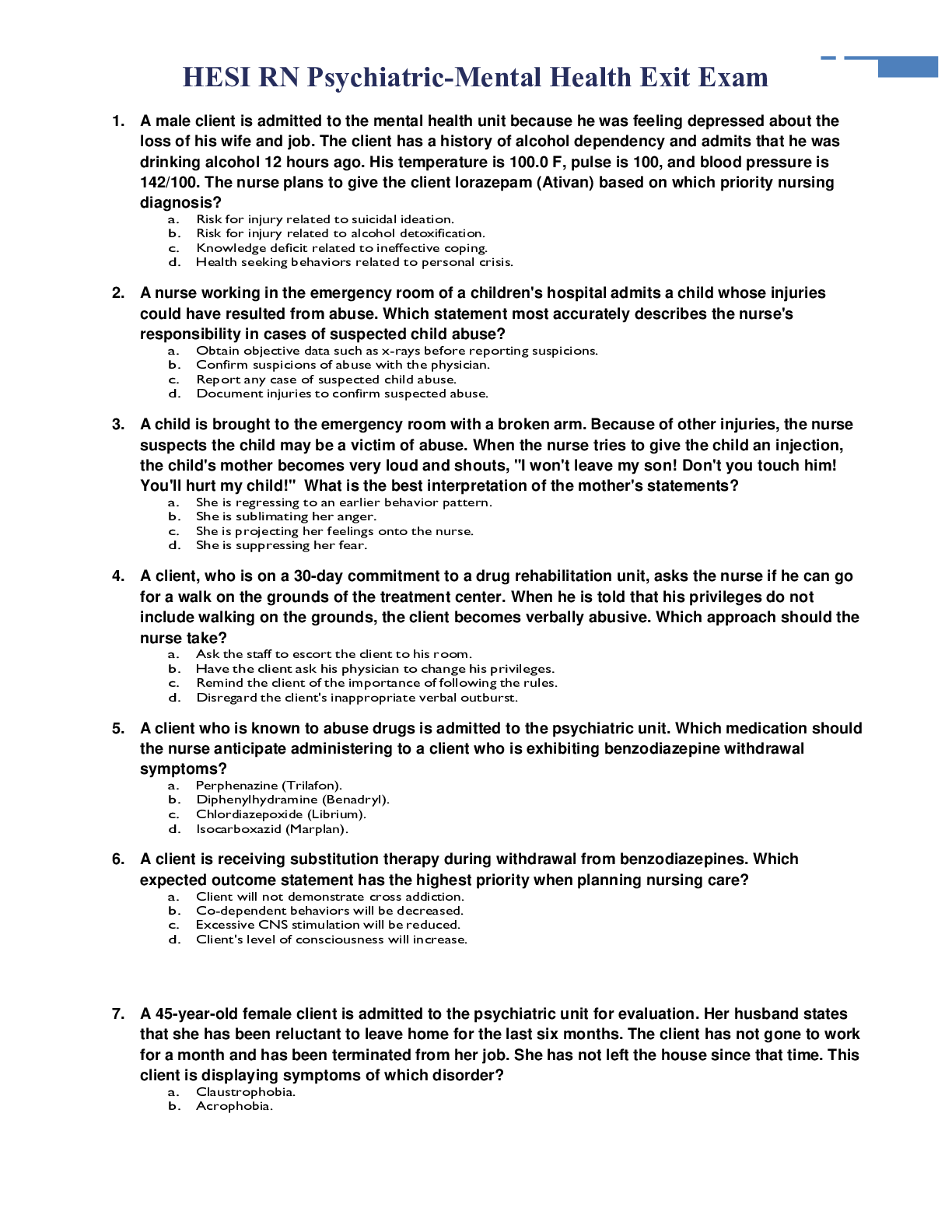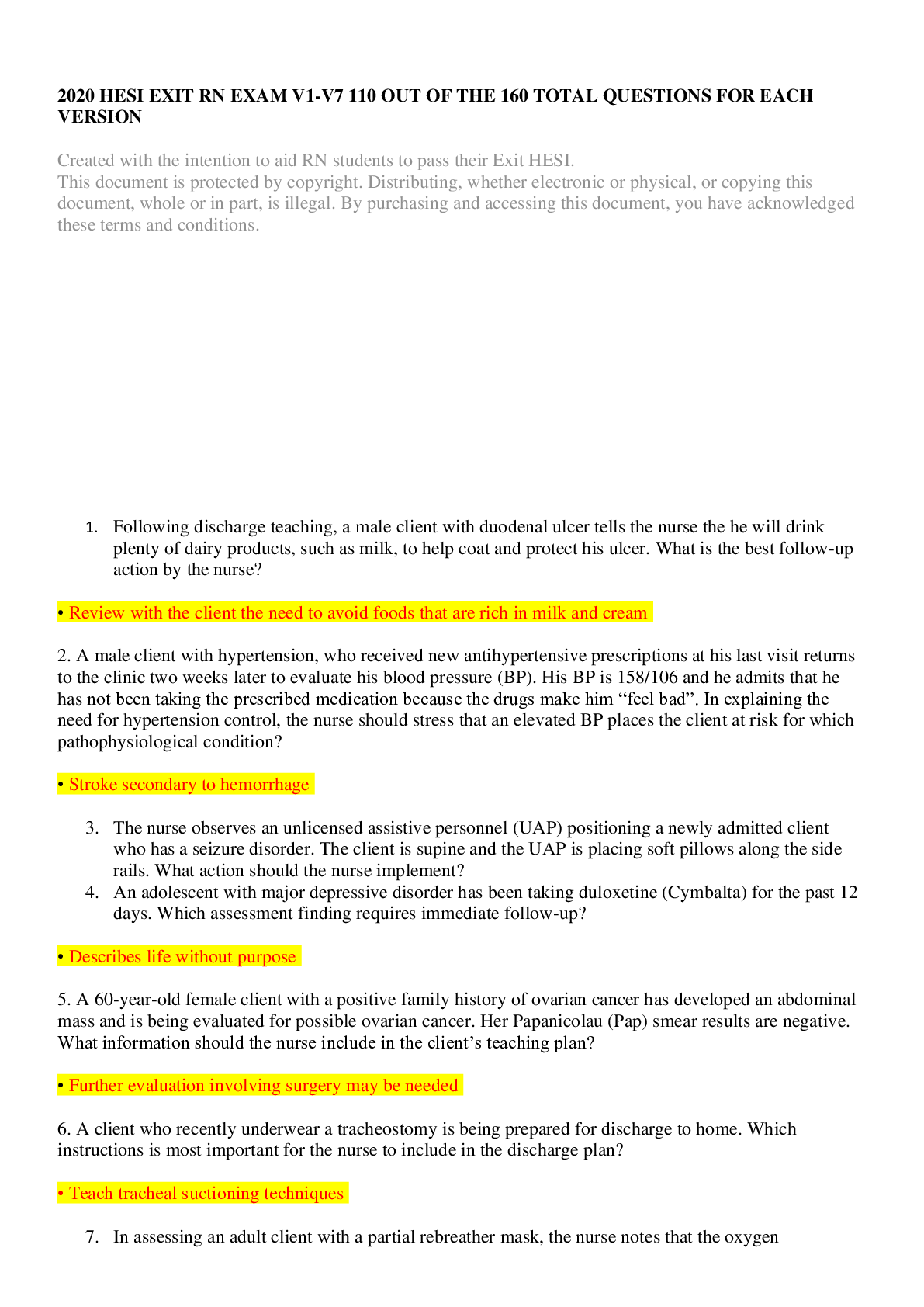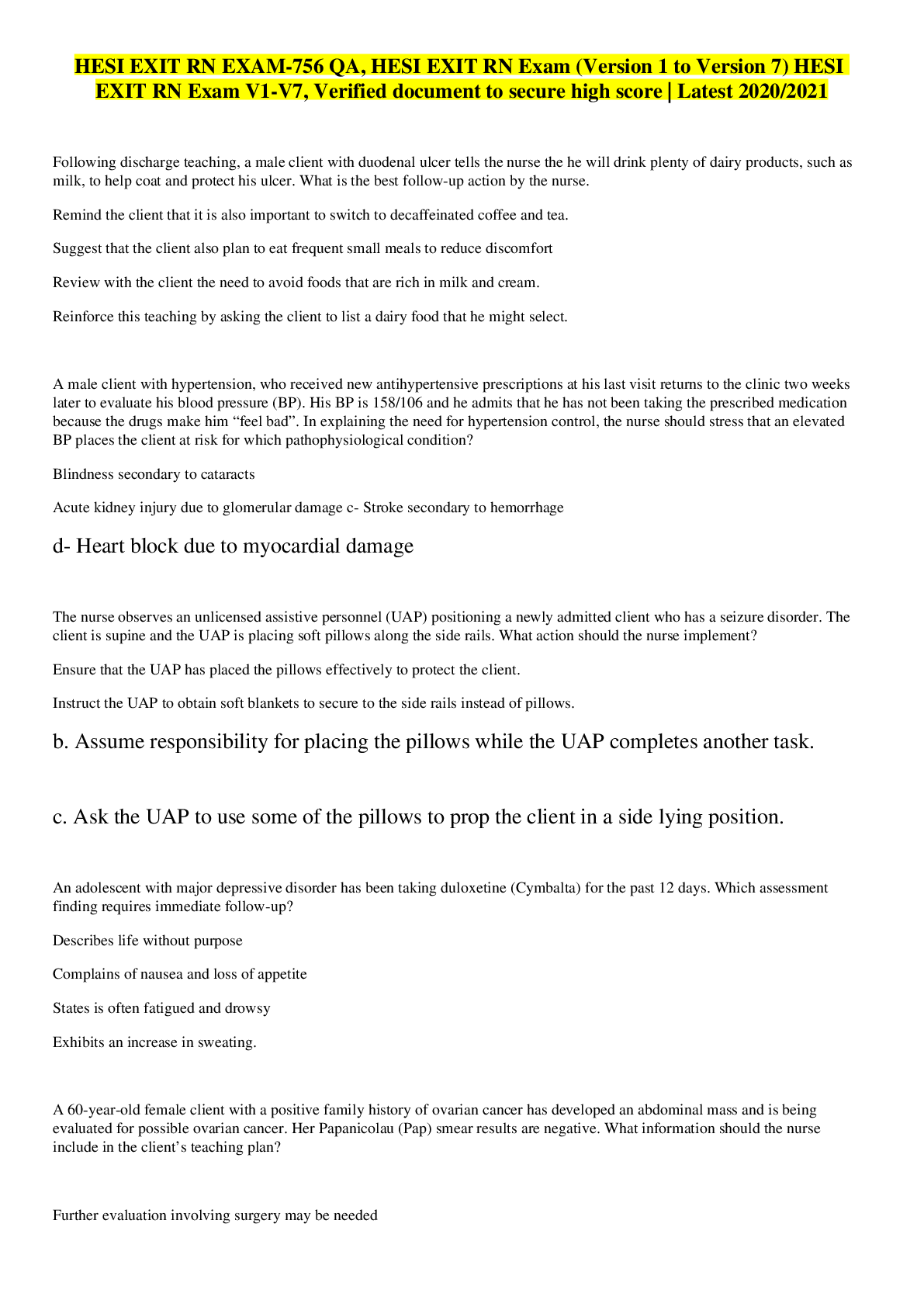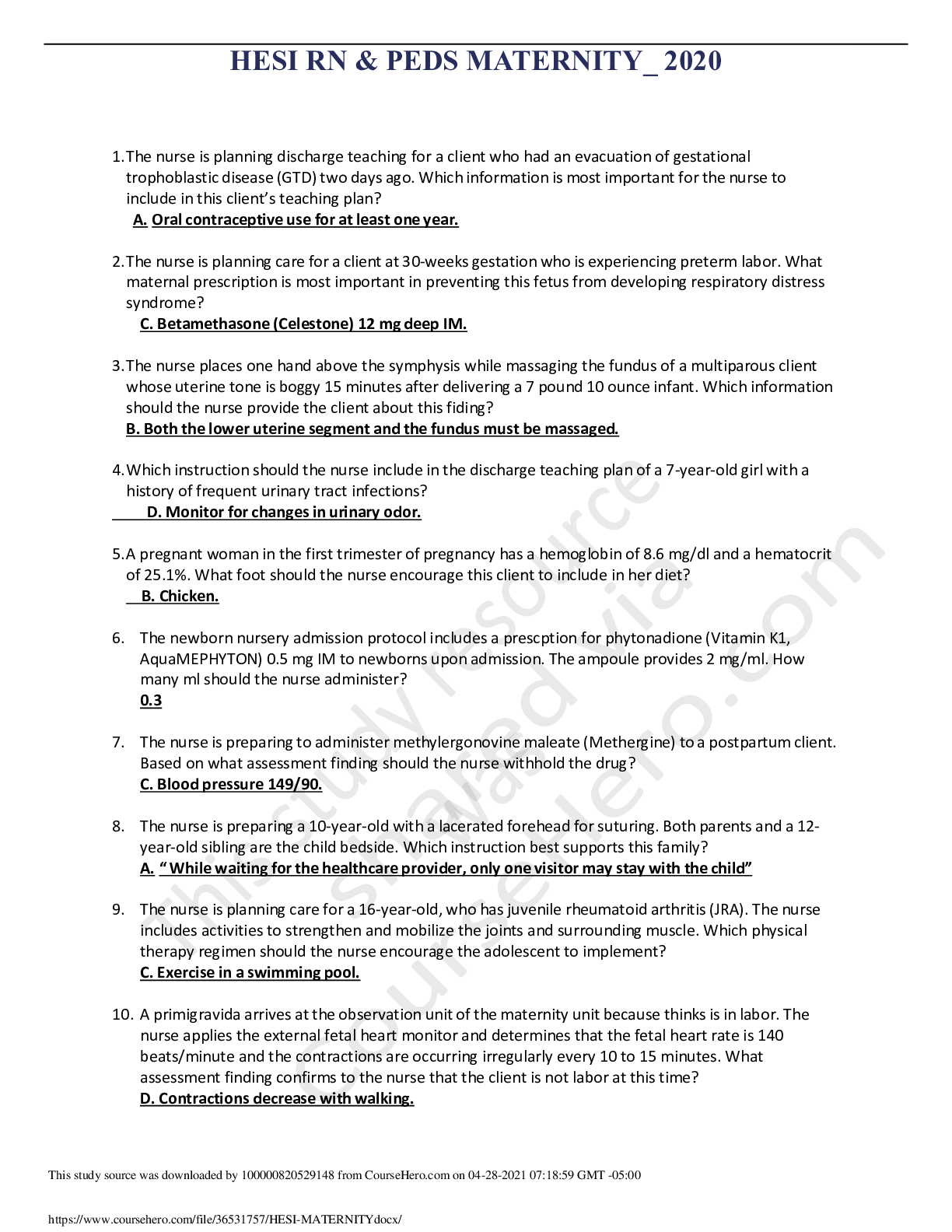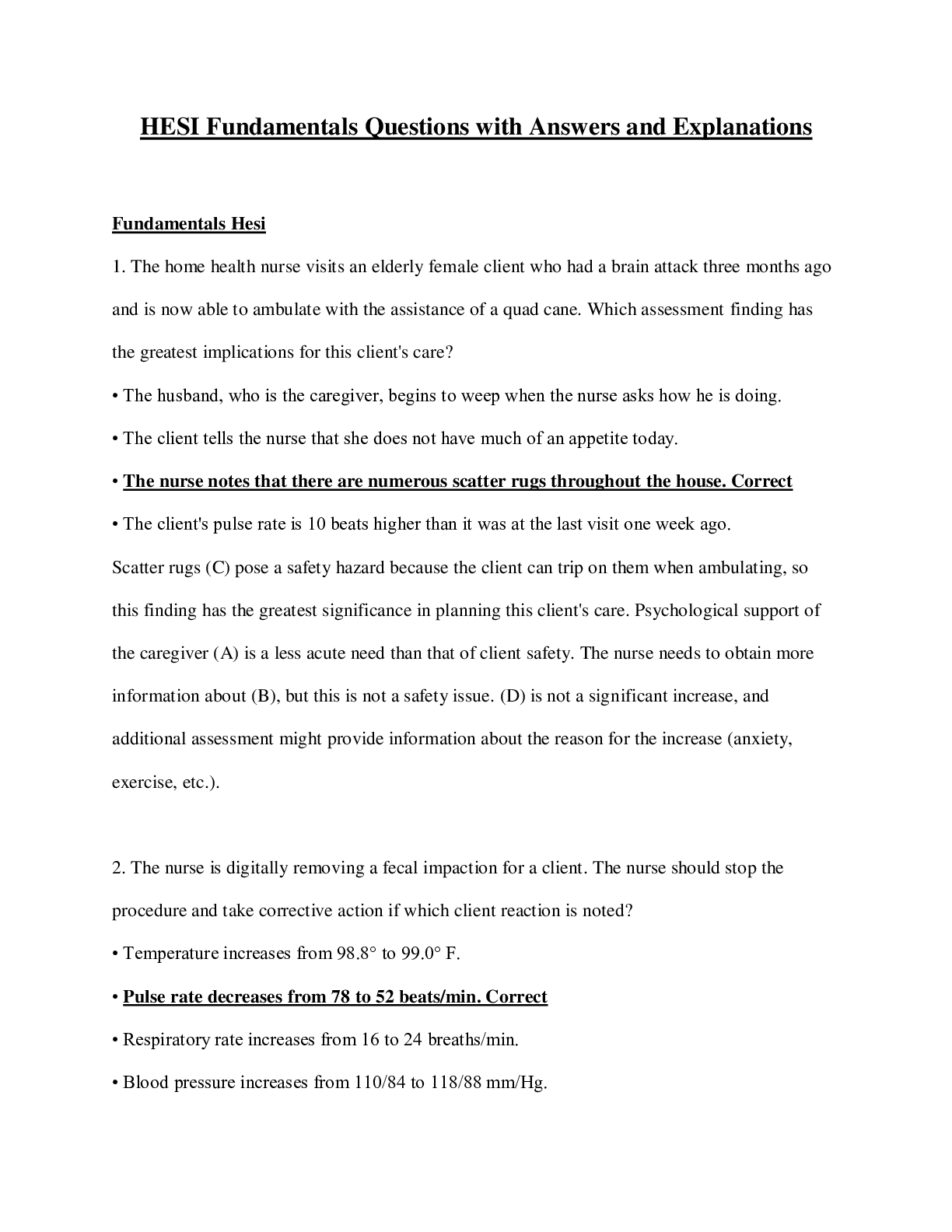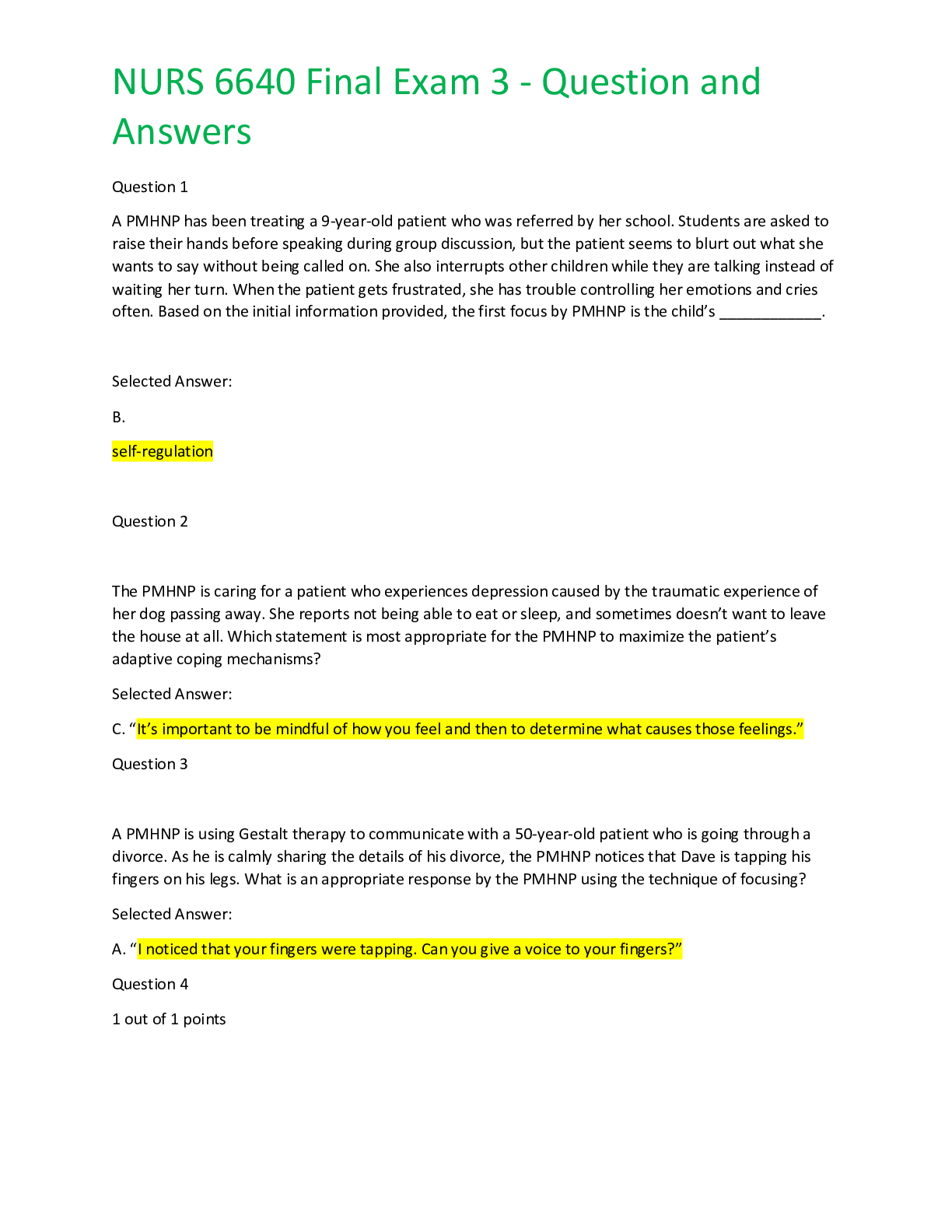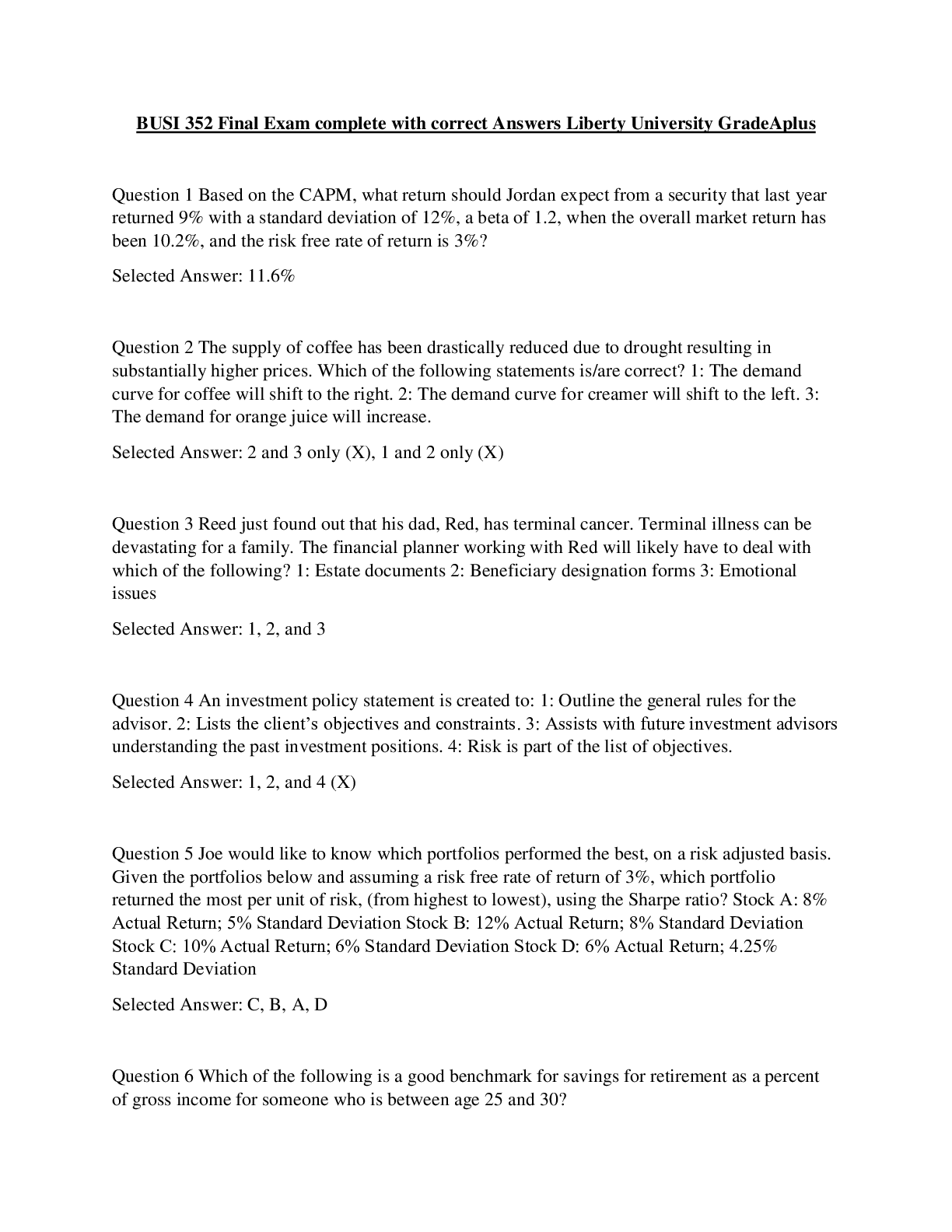Operations Management > EXAM > SBAR-Doc1.,WELL EXPLAINED WITH CORRECT ANSWERS 100%. (All)
SBAR-Doc1.,WELL EXPLAINED WITH CORRECT ANSWERS 100%.
Document Content and Description Below
Documentation Assignments 1. Document your initial assessment data of Rachael Heidebrink, including signs and symptoms related to pulmonary embolism, heparin infusion, and vital signs. • Her... VS were RR of 14, Pulse of 90 and strong in all extremities, no report of SOB, BP 120/72 left arm, T 99 F orally, she has normal elasticity, color appropriate for ethnicity, and not diaphoretic. She reports a right hip pain of 2 out of 10, but denies the need for medication. Pupils are reactive to light and 5 mm bilaterally. Mucous membranes are pink and moist. Breath sounds clear and equal bilaterally. Normal heart rate and rhythm, no murmur, and S1 and S2 noted. Bowel sounds are active in all quadrants. Capillary refill of <2 seconds. Patient has a dressing over the femur for skin lesion: clean, dry and intact and no evidence of infection. Patient moves spontaneously and follows command. No edema noted on all extremities. Foley catheter has 400 ml of urine output. She has a peripheral IV on the right arm and a Heparin 25,000 units in 250 ml D5W is running at 15.5 ml/hr (re-adjustment from 14.2 ml/hr, as ordered by the pharmacist). IV site is clean, dry, and intact. No swelling, redness, or infiltration. 2. Document the heparin infusion, including rate change. • At the beginning of the shift, the patient had a heparin drip rate of 14.2 ml/hr of Heparin 25,000 units in 250 ml D5W. The pharmacist was consulted (per MD order) and ordered a 1000 units of heparin bolus and a drip rate change. Bolus was administered and the drip rate has been changed to 15.5 ml/hr. • Calculation: 64 kg X 2 = 128 units/hr ▪ 128 / 100 = 1.28 ml/hr ▪ 1.28 + 14.2 = 15.48 rounded to 15.5 ml/hr 3. Document the patient education you provided to Rachael Heidebrink during this scenario related to the heparin infusion. Patient was educated on warfarin. This drug was added to her regimen this morning. The patient was informed that warfarin interferes with the synthesis of clotting factors in the liver, thereby leading to prevention of thrombotic events. The patient was also informed of cautions and contraindications while taking warfarin. Patient was informed that vitamin K is an antidote for warfarin. • Patient was also informed of the bleeding and bruising risks associated with the bridge therapy. Patient was informed of signs and symptoms to be aware of; including bleeding gums, excessive bruising, nosebleeds, and black/tarry stools. Patient was also informed that vitamin K may be used as an antidote to warfarin in cases of excessive bleeding, and that blood products may be necessary in severe cases of bleeding. Patient was informed that protamine sulfate is an antidote for heparin. • Patient was educated on the need for bridge therapy and its effects. The patient was informed that the addition of warfarin is used to minimize both the risk of thromboembolic events and the risk of bleeding. • Patient was informed of the adjustments made to her doses of heparin and warfarin. Adjustments to the dosage of both heparin and warfarin are made based on the results of the patient’s coagulation studies. The goal of bridge therapy is to reduce the embolus and to prevent complications associated with the embolus. To accomplish this, the patient’s aPTT, PT, and INR need to be kept within therapeutic levels. Adjustments to the dosage are made regularly to keep these coagulation lab results within acceptable levels. • [Not used in vSIM, but should be included in patient education:] - Educate patient to avoid contact sports or any other high impact activities to reduce risk bleeding/bruising. - Patient should be informed that they should avoid food that are high in vitamin K. Food like spinach and broccoli should be avoided. - Patient should be informed that regular blood tests will be needed to monitor that the medications are at therapeutic levels. 4. Document the dose of warfarin you gave in this scenario. • Bridge therapy was initiated this morning. Patient was given 5mg of warfarin PO. Coag results showed an INR of 0.9. Orders indicated a 5mg dose of warfarin for an INR below 1.5. A 5 day overlap of both warfarin and heparin is recommended for bridge therapy. Coag labs are to be drawn Q6Hours and warfarin dose is to be adjusted according to orders to ensure a therapeutic INR. 5. Document the patient education you provided to Rachael Heidebrink during this scenario related to warfarin. • Education includes follow- up with regular blood tests while on the drug to monitor coagulation factors. • To contact the health care provider for any signs and symptoms of bleeding such as bruising easily, dark-colored stools and urine, vomiting blood, bleeding with tooth brushing, round or pinpoint purplish red spots (petechiae), nosebleed, chest pain, intense menstrual bleeding, severe or continuous headache, faintness or dizziness. • Educate patients about adverse effects on medication. • Contact provider if any symptoms of hepatitis occur such as dark urine, itchy skin, jaundice, abdominal pain, light stools. • Take medication at same time each day and do not alter dose. • Educate patient on food high on vitamin K (spinach, asparagus, kale, broccoli). Patients should limit intake of these foods as vitamin K can cause PT levels to fluctuate. • Use a soft toothbrush and floss teeth gently with waxed floss. • Educate patient on avoiding IM injections and activities that can lead to injury. • Use barrier contraceptive measures while on anticoagulant therapy. And if a patient becomes pregnant while on warfarin inform the provider immediately since anticoagulant therapy poses a great risk to the fetus. • Avoid excessive intake of alcohol. • Educate patients to avoid using OTC meds, herbal drugs, especially those containing aspirin or NSAIDs. • Educate about the need to use an electric razor when shaving legs. 6. Document any repeat assessments done during this scenario. • Documentation of VS: ECG: Sinus rhythm with signs of pulmonary hypertension. Heart rate: 90. Pulse: Present. Blood pressure: 117/70 mm Hg. Respiration: 16. Conscious state: Appropriate. SpO2: 93%. Temp: 99 F (37 C) • Respiratory assessment; RR 16, chest moving equally, NO SOB • Cardiovascular assessment: BP 117/70, P 90 regular rate/rhythm • Assessment of coagulation factors such as INR, PTT, aPTT. • Assessment for bleeding: checked urine was clear yellow urine • Assessment of IV for redness/bleeding/ swelling. NO signs and symptoms of bleeding/redness/ swelling. • Assessment of Pain; 3/10 on numeric pain scale [Show More]
Last updated: 1 year ago
Preview 1 out of 5 pages
Instant download

Buy this document to get the full access instantly
Instant Download Access after purchase
Add to cartInstant download
Reviews( 0 )
Document information
Connected school, study & course
About the document
Uploaded On
May 12, 2021
Number of pages
5
Written in
Additional information
This document has been written for:
Uploaded
May 12, 2021
Downloads
0
Views
92


